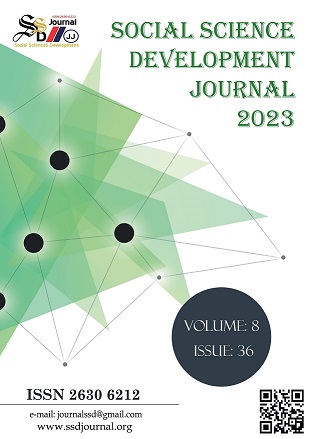THE ART OF CLOTH WEAVING WITHIN THE SCOPE OF INTANGIBLE CULTURAL HERITAGE AND EXAMPLE FOR LIVING HUMAN HISTORY MASTER TEACHER EMİNE ÖZKAN
DOI:
https://doi.org/10.31567/ssd.849Keywords:
Intangible Cultural Heritage, Handicrafts, Cloth WeavingAbstract
The urge to survive and exist has always pushed human beings to live as a community, unlike other
beings. This necessity has caused each society to build its own identity over time, and the reflex of
transferring this to the next generations has provided the basis for the existence of culture and, in
connection with this, cultural heritage. In this respect, intangible cultural heritage, which has a very
important place under the main heading of culture, is one of the most important elements of the
genetics of existence of societies. The mission of master trainers, who carry an identity more than
just a teacher, is in a much more privileged position in the transfer of this heritage, which we can
embody with the tradition of handicrafts, to the next generations. It is of great cultural importance to
make a biographical analysis of the people who perform these arts in order to research and keep
alive the handicrafts that are about to be forgotten. In this context, the subject of the study is the art
of cloth weaving, which is one of the forgotten handicrafts, and the biographical research of Emine
ÖZKAN, who has been teaching this art to her trainees for about 30 years. In the research, a
literature review was made within the framework of Intangible Cultural Heritage at first. Later, in
line with this information, Emine ÖZKAN, who has been working as a master trainer for years at
the weaving looms established in Ankara Polatlı Public Education Center, how she met the cloth
weaving handicraft, It is aimed to conduct research on how this art is made and what are the
examples of traditional handicrafts reflected today. The products that emerged with this handicraft,
which has survived from the past to the present, and the contributions of these products were
collected as data in the research. The findings obtained as a result of the research show that the art
of cloth weaving is tried to be kept alive, people are still willing to take lessons to learn this
handicraft, and after the art of cloth weaving, qualified and various products have emerged. Also, in
handicraft examples, it can be the most concrete equivalent of not only the motifs that reflect the
taste of today's cultural perception, but also the reflection of this cultural accumulation, It is seen
that there are also motifs inspired by the symbols of the ancient city of Gordion, which was the
capital of the Phrygian Kingdom, especially in the district of Polatlı. It is possible to say that the art
of cloth weaving is given importance and that there are efforts to transfer this heritage to future
generations by enabling its sustainability through various collaborations, that the traditional
handicrafts that have been uncovered also have a share in the economic development and promotion
of the district, and that this and similar arts should be further supported. It is possible to say that the
traditional handicrafts unearthed have a share in the economic development and promotion of the
district, and that this and similar arts should be supported even more. It is possible to say that the
traditional handicrafts unearthed have a share in the economic development and promotion of the
district, and that this and similar arts should be supported even more.




